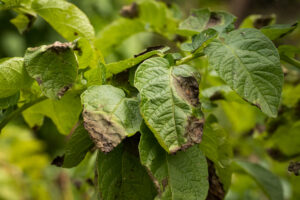Fungicide resistance management
Looking at best management practices for potato fungal diseases
(Sponsored) As growers know, fungicides have often been used to protect various crops and plants from fungal damage. However, because most fungal pathogens commonly found infecting potato plants have developed resistance (reduced sensitivity) to fungicides, the control of these diseases can be difficult. Therefore, understanding the best management practices to avoid fungal resistance to manage diseases is crucial to achieving high yields.
It is important to note that poor disease control can also result from improper application methods, application timings, and the wrong choice of a fungicide for the targeted disease.
Britt Beene, territory manager for Corteva Agriscience, works extensively with both fresh-market potatoes and processing potatoes in Rupert, Idaho. According to Beene, while practicing disease management in potatoes, it’s important to understand the potato varieties and their differences in susceptibility/tolerance to the diseases in question. In addition, the management practices may differ between fresh-market potatoes and processing potatoes and needs to be taken into account.
“Fresh-market potatoes are considered to have a shorter season where the grower would not be quite as aggressive with fungicide applications. On the other hand, processing potatoes have a longer season and growers would have to protect the crop for a longer period of time,” Beene said.
Beene also noted that growers need to look at agronomy and the different diseases that can occur in potatoes during different times of the year as well as the history of the area

“There’s a spectrum of diseases that are prevalent in the roots at planting times. It’s important to break it up into some of the general categories of the type of potato and then the specific growth stage of the potato for the diseases,” Beene said.
Best fungicide resistance management practices:
- Implement integrated disease management strategies
- Scout fields daily for signs of disease development and apply fungicides preventatively
- Rotate fungicides with different FRAC groups to reduce the selection pressure on the fungi population
- Apply the recommended label rates with adequate coverage
- Select varieties with resistance to common potato diseases
“We want to always make sure we’re growing a healthy crop; the healthy crop for a grower is the best return of investment they can make,” Beene said. “To make the best decisions for the season, growers need to approach each year differently. Every field is its own unique individual. We work to do the best job possible to improve and produce a safe, profitable, and environmentally sustainable crop.”
Different products can have different efficacy on fungal and bacterial diseases. According to Beene, choosing the right ones make all the difference: “There’s a limited number of products to choose from, so that makes the grower’s choice and selection even more important, especially if bacterial diseases are also a problem in addition to fungal diseases.”
To learn more about fungicide resistance management, visit Corteva.us/stopfungi
™ Trademark of Corteva Agriscience and its affiliated companies. © 2024 Corteva. 018867 CP (1/24)







